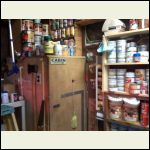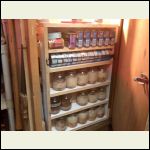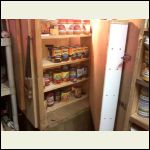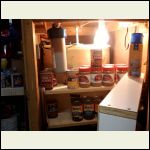|
| Author |
Message |
Julie2Oregon
Member
|
# Posted: 22 Dec 2015 04:55am
Reply
Is anyone using these in their cabin or know anyone who is? I'm trying to figure out a plumbing scheme by which my pipes/pumps/fixtures/water won't freeze if I go away for a day or more during the winter and am not there to run the wood stove or propane heater.
My thought is this: Bury my cistern and use a removable, submersible pump to draw water for inside the cabin. And then each faucet's pump (either hand or electric) will pull the water when needed from the indoor source.
The hand pump uses no energy except mine. The electric faucet uses a little 12-volt 1.6 amp pump that clips to a 12-volt battery that I could have in the cabinet next to the pump so it wouldn't draw on my solar power. When I'd go away, I could simply disconnect the pump and drain the tubing so there wouldn't be any water in the system to freeze up.
I'm not plumbing in a shower so there's no issue with that.
I'm wondering how well these faucets work. I think a hand pump would be fine for the kitchen sink and an electric would be necessary for the bathroom since I'll be hooking up a portable washer to my bathroom faucet.
I've learned that hand pumps release all of the water back to the source and won't freeze in the winter. I might consider putting a hand pump on my cistern. The rocket hand pump faucet can be locked to hold the prime or released so that the water does flow back to the tank.
|
|
Bret
Member
|
# Posted: 22 Dec 2015 09:11am
Reply
http://www.whalepumps.com/marine/product-application-items.aspx?Category_ID=10016&Fri endlyID=Manual-freshwater-galley-pumps
These are interesting.
|
|
Julie2Oregon
Member
|
# Posted: 22 Dec 2015 05:37pm
Reply
Wow, those ARE interesting, Bret! I will have to look into them via a US distributor! Thanks!
|
|
MtnDon
Member
|
# Posted: 22 Dec 2015 06:18pm
Reply
Is there going to be a water heater involved in this system? The type that is plumbed into a faucet / point of use, not a pot on a stove.
Quoting: Julie2Oregon Bury my cistern and use a removable, submersible pump to draw water for inside the cabin.
The pump does not necessarily have to be removable. The Rule inline bilge pumps like this one, do not have a foot valve. When the pump is turned off water will drain back to the level in the cistern IF the pipes / hoses are properly sloped. We use one of them as a transfer pump from underground cistern to a small storage tank in our cabin. There are other larger volume sizes as well. They are not a pressure pump, just a transfer from here to there pump with a limited head. I think a lift of about 12 feet is the practical maximum. The pump sits in the bottom of the cistern and pushes the water up.
It's impossible to say from the write upon those Whale pymps whether or not they incorporate any back flow prevention. If they do they may be a pain to empty of water to prevent freezing.
Just an opinion, but having a separate battery to operate a small faucet pump seems to be a complication when the plan is to also have some PV power;just an extra battery to keep charged. If the use of a regular RV pump like a Shurflo or Flojet going to break the PV system then the PV system is too small IMO. Just my way of looking at it. Shurflo has one that is only 1 GPM and 2.5 maximum amps on 12 VDC. And it would be enough to supply a kitchen and bath sink. Not enough for any shower though.
You also need to think about the waste water. If the sinks have P-traps those freeze. The Hepvo waterless trap may be a solution if the plumbing code is ok with it. It is not approved for residential use in the USA. Some RV's use them.
|
|
NorthRick
Member
|
# Posted: 22 Dec 2015 07:26pm
Reply
Put an indoor tank in the attic/ceiling. Plumb a line with a pump from your cistern into the top of the tank. Right next to that plumb a drain line from the bottom of the ceiling tank back to the cistern with a valve in a convenient location. Make it as vertical as possible.
Then have other lines from the ceiling tank feed your faucets and shower. Make those so there are no low spots.
To use, pump water from the cistern into the ceiling tank until full. Use gravity to get the water from that tank to your faucets and shower. If the place is going to be left unheated during freezing weather, simply open the valve and drain the upper tank into the cistern. Open the faucets to drain those lines.
You could keep a jug of RV antifreeze and pour a little into each drain to keep the traps from freezing.
|
|
darz5150
Member
|
# Posted: 22 Dec 2015 08:21pm
Reply
Quoting: Julie2Oregon My thought is this: Bury my cistern
Question: will you have to haul water in to fill the tank, or rainwater catchment system? We have a closed water system. I haul our water in, then transfer some to an indoor storage tank.
There is a well on the property, but we are located above old coal mines and the water is not so good.
|
|
Julie2Oregon
Member
|
# Posted: 23 Dec 2015 01:12am - Edited by: Julie2Oregon
Reply
Quoting: MtnDon Just an opinion, but having a separate battery to operate a small faucet pump seems to be a complication when the plan is to also have some PV power;just an extra battery to keep charged. If the use of a regular RV pump like a Shurflo or Flojet going to break the PV system then the PV system is too small IMO. Just my way of looking at it. Shurflo has one that is only 1 GPM and 2.5 maximum amps on 12 VDC. And it would be enough to supply a kitchen and bath sink. Not enough for any shower though.
I think that Shurflo pump is the Nautilus? It's the one that goes with the electric faucet I'm looking at. It's a single appliance pump but, yes, that's exactly what I had in mind. Nah, the power usage is negligible but logistically, I was wondering how you hook up a VDC appliance? It looks like you have to either need a battery to clip with wires to or you have to install a special VDC plug, fuse, etc. and an adaptor on the appliance? How does that work? I thought that clipping the wires to a motorcycle-sized battery would be easier but maybe not?
Quoting: MtnDon Is there going to be a water heater involved in this system? The type that is plumbed into a faucet / point of use, not a pot on a stove.
No. No shower plumbed in, either.
Regarding the bilge pump, how would the pipes have to be sloped? My land is totally level so I'd have to create some sort of slope. Truth be told, after my cabin passes inspection, the plan would be to put a small tank in my crawlspace and have the faucet tubing connected to it. So I'd be transferring water from the cistern to the small tank.
The drain pipes will be hooked up to the greywater filter system in the crawl space. Will that help to prevent freeze-up or make things worse? 
|
|
Julie2Oregon
Member
|
# Posted: 23 Dec 2015 01:26am
Reply
NorthRick
That was my original plan but 2 things concerned me. The first was the weight of the water tanks on my loft floor (It's only a half-loft and not a full second floor.). The second is the amount of lift required to take the water from the buried cistern up through to the loft. The cabin will be a gambrel. I've done a redesign since earlier in the year to maximize square footage.
I may need to take a look at it again, though. Thanks! 
|
|
|
Julie2Oregon
Member
|
# Posted: 23 Dec 2015 01:31am
Reply
darz5150
I'll be doing all of the above, as conditions warrant, lol. I'm doing rain and snow catchment, bringing in some water, and delivery for the rest. It doesn't rain much during the summer there so that's when I'll need delivery the most. I'll always buy drinking and cooking water, though.
|
|
MtnDon
Member
|
# Posted: 23 Dec 2015 01:50pm - Edited by: MtnDon
Reply
Quoting: Julie2Oregon I was wondering how you hook up a VDC appliance?
Any wires that connect to the battery or batteries need a fuse or circuit breaker near the source end (battery). A big one if it is for an inverter. Smaller ones sized to suit the smaller wires and smaller loads for things like lights or a water pump. Fuse or breaker goes in the + line.
So then from the fuse that would be for the pump, you'd run a + and a - wire to the pump. Connect the pump to that using wire nuts or some similar device. I'd put an on-off switch in there, probably close to the pump.
Then the pump plumbing can send water to bath and kitchen sinks.
You could place a holding tank in the attic, just have to size the support structure for the load. Water = 8.33 lbs per gallon, plus tank. Then you might be able to do w/o the pump. Just have to be patient as the flow won't be real fast. Whether or not works well will also depend on whether the cistern transfer pump can push the water that high. The Rule IL500P might be a better choice. You'd have to check the specs to see what the lift distance is rated at and the volume at the height. . Remember, the higher the lift the less the per minute volume. Grainger.com lists the pumps along with specs, IL200P, IL280P, IL500P
|
|
darz5150
Member
|
# Posted: 23 Dec 2015 10:07pm
Reply
Here's a few pics of our set up. I am not claiming that it is the best, but it has worked for us for about ten years with very few problems.
I built a lean to style storage room on the outside of the original cabin. That is where I built a water closet (that's what we call it ) and inside it holds a 55 gal. food grade barrel. I built it so the barrel sits at the same level as the cabin floor so it wouldn't over work the pump.
First pic shows the closet. Next shows the shelf that is hinged to swing out of the way for more storage/access. The next is another shelf for can goods etc. The last shows the tank behind the shelf. I filter the water when I transfer it from my water wagon to the barrel. You can see the light bulb in the closet. That keeps everything from freezing, and you should be able to power it from a small solar barrel.
I put sharpie hash marks on the barrel. I clocked them in minutes so I didn't have to stand there and watch it fill. So that means from about 1/3 of the way down the barrel I marked 10 minutes, then incrementally working towards the top of the barrel, it counts down to 1 minute....before I overflow the barrel. That way I can go feed the chickens or take out the trash, and simply have to look at the marks to know how much fill time is left.
I use sureflo pumps, 1 to transfer water from big tank, 1 for the cabin. 1.8 GPM I believe. We have a double kitchen sink, bathroom sink, RV toilet and a shower. Plenty of water pressure. I used bigger pumps before, 5 GPM, but they wasted way too much water.
My wife and I only use 600 gallons per month. My water wagon holds 325 gallons, so I make 2 water runs per month.
water closet
| 
first shelf
| 
second shelf
| 
barrel and filter
|
|
|
Julie2Oregon
Member
|
# Posted: 25 Dec 2015 08:06pm
Reply
MtnDon
Thanks for the info! 
I think pumping water from an underground cistern up to a loft tank would be problematic. Better to have a holding tank in the crawl space or do something like darz5150 has.
|
|
Julie2Oregon
Member
|
# Posted: 25 Dec 2015 08:26pm
Reply
darz5150
That's a neat setup! Thanks for posting pics and all! Something like that would work for me, too. I don't think I'll be using more than 15 gallons of water/day.
|
|
|

